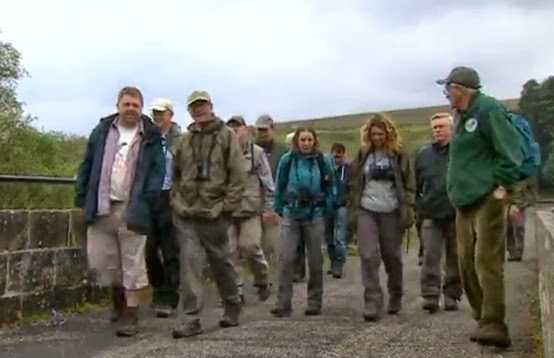 |
| One of many - Lapwings |
The first time we tried
to get to Nottingham we had to turn back after 4hrs, grid lock on the M6 after an
accident, not the best way to spend husbands’ birthday!.. Travellers beware. A month later we finally got
there, not without further traffic snarl ups and worse I left my binoculars behind! Still...
The reserve has a large
car park, no fee, nor entrance cost, but donation recommended similar to Mere
sands wood reserve.
My initial impression
of the reserve is a mature version of Brockholes, similar habitats, large
walking area, but more overgrown. I was particular pleased to find a tower
hide, always good to view from on high, over the reeds! Access pretty good with
benches dotted about to tally on. Again the visitor /café although smaller
reminded me of Brockholes, set by the lake, nice food and yes if you want to feed
the ducks, swans, geese and coots they’re waiting for you. Bird food on sale in
shop.
 |
| Nature centre |
We went in August,
the weather wasn't particular good which probably meant some birds were skulking
away, however the highlight came within five minutes of starting our walk, as we stopped on Barton lane overlooking the Tween pond a kingfisher flew past us, closely followed by a hair stirring common tern overhead! Lots of tufties, mallard, coot,
grebe, mute swan on lakes, geese and herons on the river, mixed tit flocks, sparrows,
blackbirds and thrushes in the undergrowth, sedge warblers in the reeds. Common terns
and black headed gulls were on posts on the Coneries pond. Lots of Lapwings on
the works pond, buzzard and kestrel over the Erewash fields (llamas minding a sheep
flock here!)
 |
| Works pond |
Butterflies,
dragonflies and damselflies were noticeable along the river path vegetation,
along with a couple of little voles scurrying across.
Quite at few welcome information boards insitu
On
the south west edge of the Nottingham, the Attenborough Nature Reserve is a
mostly quiet haven. Managed by Nottinghamshire Wildlife Trust, the 360 acres of
lakes, wetland, grassland, woodland and scrub, a Site
of Special Scientific Interest (SSSI) it’s squeezed between the railway and the
River Trent. The extraction of river gravel created the lakes. The reserve lies
around these flooded gravel pits and the created habitat attracts wildlife,
especially the birds for which it is best known. There are large lakes formed by the
flooded pits, known as Church Pond, Clifton Pond, Coneries pond, Main Pond, Tween Pond and
Beeston Pond, plus drier areas of scrub and grassland such as Corbetts Meadow
and Erewash field
 |
| Main pond |
 |
| Coneries pond |
The
spire of St Mary’s church in the centre of Attenborough village and is visible
from most points across the reserve, and it is the village that gives the
Nature Reserve its name. Sir David Attenborough, who opened the reserve in
1966.
 |
| Terns |
The
reserve is an important over wintering site for wildfowl i.e. shoveler,
goldeneye, goosander, wigeon and large numbers of mallard and
teal. For several
years several Bittern, have spent the winter in the reserve. In the
summer, the breeding birds include great crested grebe, shelduck, little ringed
plover and common tern, for which tern breeding platforms are provided. Reed
and sedge warblers in the reed beds.
The
reserve was busy with families and its criss-cross reserve paths are used by
bike riders. The paths provide a range of views; are surfaced and are mainly
flat so give easy access for those in wheelchairs and other disabled users. There
was one point on the walk where a kissing gate may be considered narrow, path alongside
the railway leading from Erewash field to nature centre.
 |
| River Trent |
The
riverside path forms part of the Trent Valley Way, a long distance footpath
that follows the River Trent, on the opposite side there is some farmland proved
to be popular with canadian and greylag geese . From here I could hear skylark and
yellow hammer.
 |
| Tower hide |
 |
| Clifton Pond from Tower hide |
 |
| Tween Pond for Tower hide |
The
reserve has three hides, one of the best
being a tower hide giving view over the Tween and Clifton ponds (sorry no disabled
access) On the day we went I met a lady who told she’d seen
a Bittern 3 times during the winter months from the hide- in the Clifton pond.
You will need to get the access code from the centre for the Delta hide. There are
also viewing screens along the paths.
The
reserves Nature Centre has a small shop and is the base for The Wildlife
Trust’s educational activities. Depending on the time of year there are screens
showing what is happening in nest boxes and elsewhere on the reserve. At the back
of the centre a doorway leads to a seated bird feeding area and access to the new
sand martin nest/bank hide.
 |
| Sandmartin Bank |
The
Nature Centre café does meals; soups, sandwiches cakes recommended after a mornings
exploration of the reserve, we sat on the balcony and had cake and coffee, well
you have to…
On A6005, seven miles south west of Nottingham on the River Trent.
Google Maps.
More
information:




























